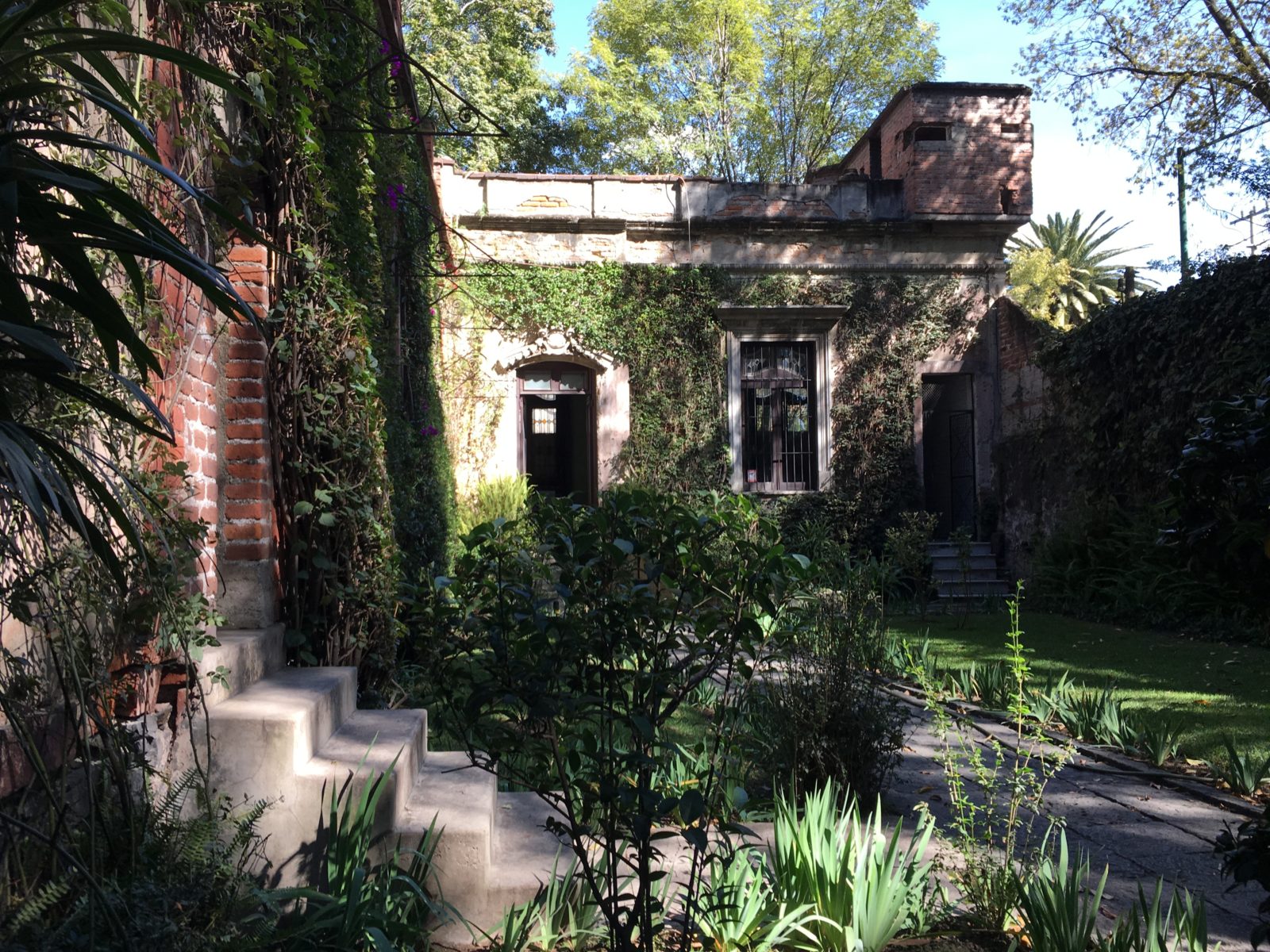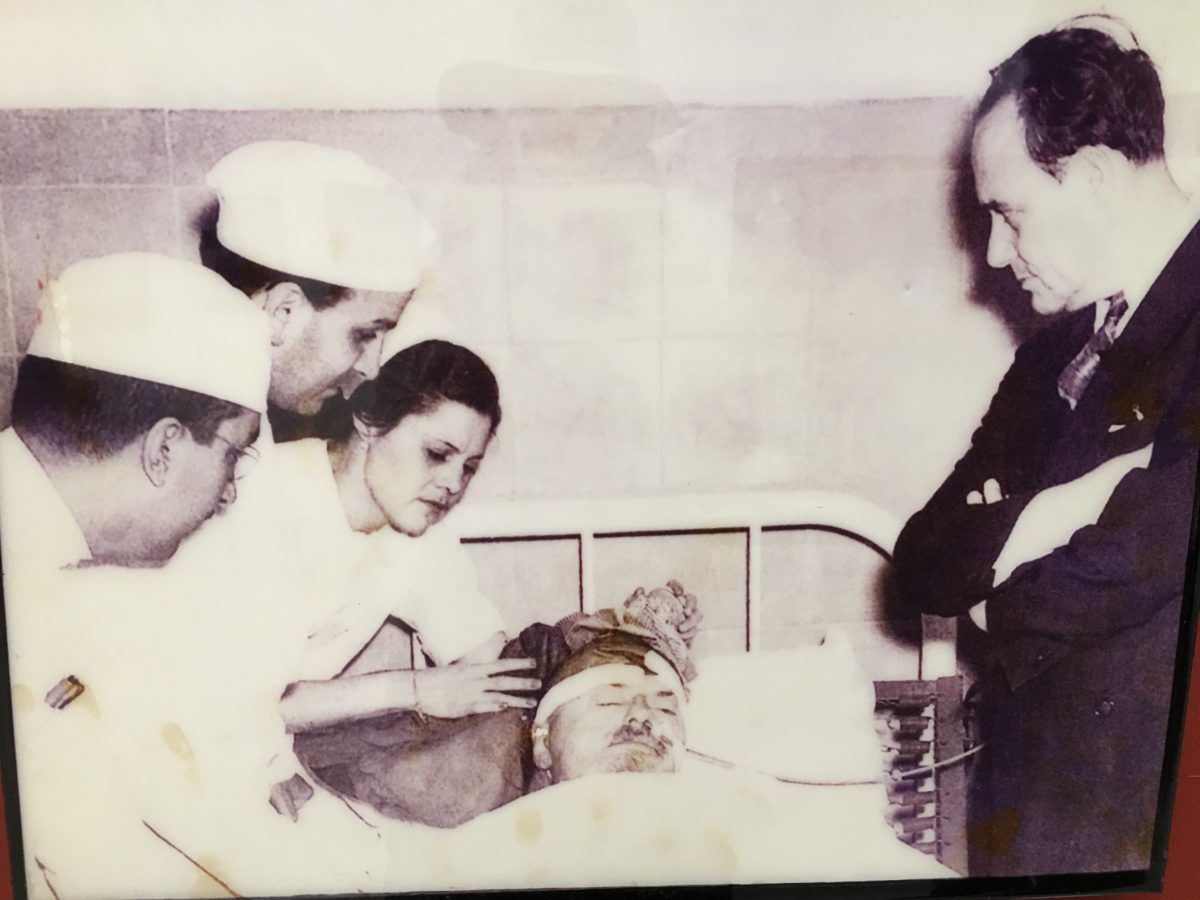The home-in-exile of the Russian communist notable Leon Trotsky is just a few blocks away from the Casa Azul so of course we had to drop in. I vaguely remembered Trotsky from my political science studies in school; with Josef Stalin and Vladimir Lenin, he was prominent in the Russian Revolution as it progressed through Bolshevism and into Communism and the Soviet Union. Trotsky was head of the Red Army.
While Frida Kahlo’s house is full of color and light and art, her neighbor and sometimes friend Leon Trotsky lived in a dimmer, dingier place. (There’s supposed to be a ‘featured image’ at the top of the post, but it seems not to be viewable in mobile devices, so maybe it will show up in the photo Gallery below). And someone in the peanut gallery is saying, well look at where they came from. No wonder her Mexican light is sunnier than his high-latitude somber.
Memorably, maybe from a Trivial Pursuits card, Trotsky was assassinated by being bashed in the head with an ice axe. That’s the event that took place in this house, and why, perhaps, it is still a public attraction. We were two of the five visitors in attendance.
But how and why did an exiled communist leader come to be living in Mexico City, and why was he finally assassinated so long after the tempest of the Russian Revolution? The Wikipedia entries on this subject are, I hate to say, more than I want to know. The particulars about whether government would lead the people, or whether the workers should be empowered first caused everlasting infighting. These people disagreed about everything, it seems.
Suffice it (I hope) to say that Trotsky was an ally of Lenin. As head of the Red Army, he seemed an obvious choice to succeed Lenin, who suffered a series of strokes starting in 1922. However, when Lenin died in 1924, Trotsky was politically outmaneuvered by Joseph Stalin. Here I am quoting and paraphrasing from http://history1900s.about.com/od/people/p/trotsky.htm
From that point on, Trotsky was slowly but surely pushed out of important roles in the Soviet government. First he was exiled to the very remote Alma-Ata. Apparently that wasn’t far away enough, so in February 1929, Trotsky was banished from the entire Soviet Union.
Writing prolifically during his exile, Trotsky continued to criticize Stalin and his increasing bureaucratic grasp, from homes in Norway, Turkey and France. He came to Mexico in 1936 under the aegis of Diego Rivera and Frida Kahlo, and lived in the Casa Azul for a year or so.
Then there was some kind of disagreement, and eventually Trotsky moved to this house a few blocks away.
Stalin, meanwhile, named Trotsky as the major conspirator in a fabricated plot to remove Stalin from power. As part of the Great Purge, 1936-1938, 16 of Stalin’s rivals were charged with aiding Trotsky in this treasonous plot.

All 16 were found guilty and executed. Trotsky, condemned in absentia, was also on the execution list.

On May 24, 1940, at 4 AM, Soviet agents broke in and machine-gunned Trotsky’s house in Coyohuacan. Although Trotsky and his wife and grandson were home asleep, all survived the attack. The tour guide carefully points out bullet holes in the wall just above the bed of Trotsky’s 8-years old grandson, and adds the comment that this attack failed because the would-be assassins were drunk.

Trotsky knew that he would always be a target and had taken several security measures.

Watch towers were built in the corners and the perimeter wall was raised.

The lovely big windows still stand but the bottom portions on the perimeter are bricked in. And doorways were reduced to slow down an intruder.

Imagine being so constantly reminded of how endangered your life might be! Trotsky was said to work hard on his writing and publications in opposition to Stalin’s brand of Communism. And in his spare time, he bred chickens – the coops, but not the chickens, are still there along a side wall.
On August 20, 1940, Trotsky was not so lucky. An insider, friend to Trotsky’s secretary, and Mexican Communist named Ramon Mercader, gained access to his study. As Trotsky was sitting at his desk in his study reading a document Mercader had brought him for editing, Mercader punctured Trotsky’s skull with a mountaineering ice pick.

Trotsky was cogent enough to indicate that Mercader should be held rather than be shot by the guards, but died of his injuries the next day. Mercader served twenty years in Mexican prison, was decorated by the Soviet Union after his release, and died in Cuba in 1978.

so, that’s the history of Leon Trotsky’s death in Mexico City as gleaned by an interested observer visiting the museum that has taken over his house. Hope it kept you awake, perhaps contemplating how and why these same ‘interventions’ are managed these days in the Soviet Union. (And elsewhere, perhaps)